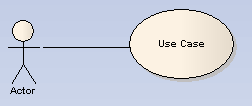

An Association implies two model elements have a relationship, usually implemented as an instance variable in one Class. This connector can include named roles at each end, multiplicity, direction and constraints. Association is the general relationship type between elements. To connect more than two elements in an association, you can use the N-Ary Association element .
When code is generated for Class diagrams, Associations become instance variables in the target Class. The relationship is also used in Package, Object, Communication and Deployment diagrams.
Toolbox Icon
![]()
OMG UML Specification
The OMG UML specification (UML Superstructure Specification, v2.0, p. 81) states:
"An association specifies a semantic relationship that can occur between typed instances. It has at least two ends represented by properties, each of which is connected to the type of the end. More than one end of the association may have the same type. When a property is owned by an association it represents a non-navigable end of the association. In this case the property does not appear in the namespace of any of the associated classifiers. When a property at an end of an association is owned by one of the associated classifiers it represents a navigable end of the association. In this case the property is also an attribute of the associated classifier. Only binary associations may have navigable ends."


